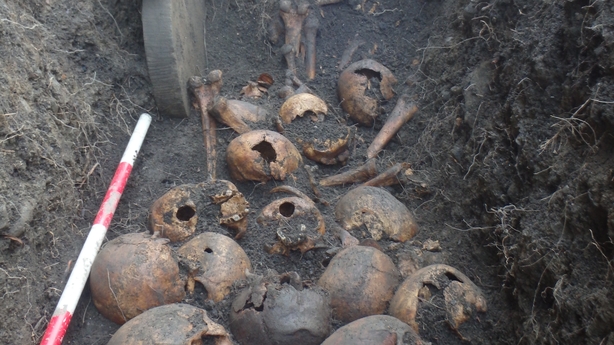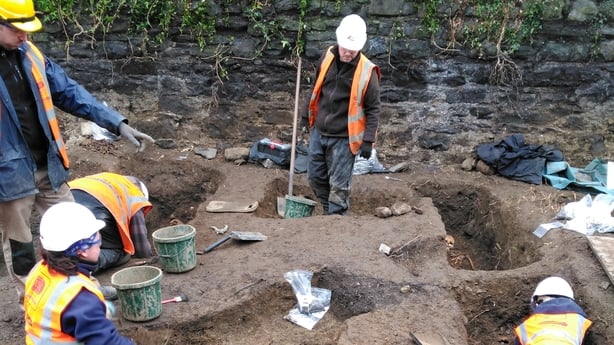The remains of more than 1,600 people who died during the cholera pandemic of 1832 have been reinterred in Dublin's Glasnevin Cemetery.
Their remains were recovered between 2015 and 2016 during excavation work as part of the Luas Cross City project.
Around 22,000 Irish people lost their lives during the cholera pandemic between March and December 1832. Around 6,000 of the deaths occurred in Dublin.
It was the second cholera pandemic of the century, the first occurred between 1817 and 1823.
We need your consent to load this rte-player contentWe use rte-player to manage extra content that can set cookies on your device and collect data about your activity. Please review their details and accept them to load the content.Manage Preferences
Due to its highly infectious nature, many victims were buried in mass graves.
During the excavation works more than 19,000 individual bones were discovered in a laneway between Grangegorman and Broadstone.
They are believed to be patients of the former Richmond Female Penitentiary in Grangegorman which was used as the 'Dublin Cholera Hospital' from April 1832.
Records suggest that its gardens came into use as burial grounds in May 1832 after a previous site at Bully's Acre in Kilmainham quickly reached capacity as the pandemic hit Ireland.
In 2010, the Environmental Impact Assessment for the Luas Cross City Project identified Grangegorman Laneway as a potential graveyard, but there was some uncertainty about its exact location.

Records indicated that the burials may have been disturbed, exhumed and reinterred in a patch of ground after three acres of the Penitentiary site was purchased by the Midland Great Western Railway in the 1870s for the expansion of their Broadstone railyard.
In 2015, archaeological test excavations from Luas Cross City identified two trenches containing the thousands of human remains
Post-excavation analysis over five years confirmed they were the remains of 1,617 victim of the cholera pandemic.
However, individual identification was not possible due to the age and nature of the remains.

This morning, a ceremony was held in Glasnevin Cemetery in Dublin to unveil a plaque at the site where the victims' remains have been reinterred.
A headstone that was recovered along the remains has also been located on the spot they were buried.
Transport Infrastructure Ireland said it was important to all involved in the project that the remains were reinterred in a suitable resting place.
"The excavation of the cemetery was an extremely difficult task for all involved, particularly due to the nature of human tragedy the works represented," the statement said.
"From the outset it has been the wish of TII to ensure these individuals were treated with the utmost respect.
"Through this formal burial in consecrated ground, it is the intention of TII and Glasnevin Cemetery Trust that the dignity of these individuals is restored, that their loss is never forgotten, and that they may now truly rest in peace."
Archaeologist 'taken aback' at scale of discovery
The Project Archaeologist for the Luas Cross City Project said the team were taken aback when they realised the extent of the human remains at the site in the north inner city.
"The volume of what we found was something that we just couldn't even anticipate. As we done our excavation, we'd only found a shallow trench but as it was on a bit of a slope, the trench deepened as we went along.
"Initially, we thought there was maybe 600 humans and at that, we were actually quite shocked by that, but the trench deepened more and more."
"The volume and the condition was just like something we had never seen before. As archaeologists, were very used to handling human remains, but nothing in the manner that we'd seen.

"Because they had been exhumed by non-specialists at the railway workers, while they did as much care as they could it was just a mass of intertwined,and co-mingled remains which was very difficult to deal with."
"When you're seeing humans in this form, it's incredibly difficult to separate out the tragedy of it.
"Like archaeologists are scientists at the end of the day, and you can close yourself off, but when you see them piles and piles of human bones with no dignity, knowing that this would have been not what they had wanted for their happen to their remains."
She said the team were deeply impacted by the discovery and determined to find a suitable resting place for the remains.
"Burial grounds are at capacity all over the country, so to finding burial for 1600 is incredibly difficult task, and we're incredibly grateful for Dublin Cemetery's Trust that they had this area of land, which is their conservation area, that they were able to say, yes, we have capacity, and yes, we're more than happy to help you in this situation and treat these people fairly."
"We were all greatly impacted by what we had to see and deal with on this site. None of us would have rested easy with the option of just putting them in a vault somewhere and walking away.
"We really wanted to see this through and let them know that they mattered. Maybe their family don't know where they are anymore and we don't know where their family are, but they really did matter to people."







